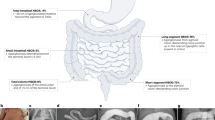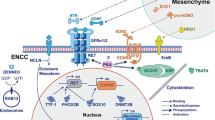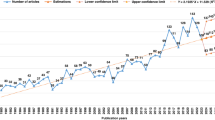Abstract
Hirschsprung’s disease (HSCR) is a congenital disorder characterized by intestinal obstructions due to the absence of enteric ganglia along variable lengths of the intestinal tract. RET coding mutations have been found in approximately 50% of familial cases, but they only explain a minority of sporadic cases. Here, we report our investigation of a possible role of RET non-coding mutations in sporadic HSCR patients. The haplotypes of seven single nucleotide polymorphisms (SNPs), all located in a region 4 kb upstream of the gene through to 23 kb of intron 1, and one SNP in exon 2 were constructed in 125 Han Chinese patients with sporadic HSCR and in 148 Han Chinese controls. Our results indicated that eight SNPs were significantly associated with HSCR (P < 0.0001). The C allele of rs2505535 would appear to represent a protecting allele for the Chinese population. One single haplotype composed of these eight markers was present in 59.6% of patients, versus 18.1% of controls. Based on our results, we conclude that non-coding mutations in RET have important roles in the development of HSCR. The unknown functional disease variant(s), with a dosage-dependent effect in HSCR, is likely to be located in the 5′-region of the RET gene.
Similar content being viewed by others
Log in or create a free account to read this content
Gain free access to this article, as well as selected content from this journal and more on nature.com
or
References
Amiel J, Sproat-Emison E, Garcia-Barcelo M, Lantieri F, Burzynski G, Borrego S, Pelet A, Arnold S, Miao X et al (2008) Hirschsprung disease, associated syndromes and genetics: a review. J Med Gene 45:1–14
Angrist M, Bolk S, Thiel B, Puffenberger EG, Hofstra RMW, Buys CHCM, Cass DT, Chakravarti A (1995) Mutation analysis of the RET receptor tyrosine kinase in Hirschsprung disease. Hum Mol Genet 4:821–830
Bolk S, Pelet A, Hofstra RMW, Angrist M, Salomon R, Croaker D, Buys CHCM, Lyonnet S, Chakravarti A (2000) A human model for multigenic inheritance: phenotypic expression in Hirschsprung disease requires both the RET gene and a new 9q31 locus. Proc Natl Acad Sci USA 97:268–273
Borrego S, Wright F, Fernandez R, Williams N, Lopez-Alonso M, Davuluri R, Antinolo G, Eng CA (2003) Founding locus within the RET proto-oncogene may account for a large proportion of apparently sporadic Hirschsprung disease and a subset of cases of sporadic medullary thyroid carcinoma. Am J Hum Genet 72:88–100
Brooks AS, Oostra BA, Hofstra RM (2005) Studying the genetics of Hirschsprung’s disease: unraveling an oligogenic disorder. Clin Genet 67:6–14
Burzynski GM, Nolte IM, Osinga J, Ceccherini I, Twigt B, Maas S, Brooks A, Verheij J, Plaza Menacho I, Buys CHCM, Hofstra RMW (2004) Localizing a putative mutation as the major contributor to the development of sporadic Hirschsprung disease to the RET genomic sequence between the promoter region and exon 2. Eur J Hum Genet 12:604–612
Burzynski GM, Nolte IM, Bronda A, Bos KK, Osinga J, Plaza Menacho I, Twigt B, Maas S (2005) Identifying candidate Hirschsprung disease associated RET variants. Am J Hum Genet 76:850–858
Chakravarti A, Lyonnet S (2002) Hirschsprung disease. In: Scriver CS, Sly WS, Valle D, Beaudet AL (eds) The metabolic and molecular bases of inherited disease. McGraw-Hill, New York, pp 6231–6255
Edery P, Lyonnet S, Mulligan LM, Pelet A, Dow E, Abel L, Holder S, Nihoul-Fekete C, Ponder BA, Munnich (1994) A mutations of the RET proto-oncogene in Hirschsprung’s disease. Nature 367:378–380
Emison ES, McCallion AS, Kashuk CS, Bush RT, Grice E, Lin S, Portnoy ME, Cutler DJ, Green ED, Chakravarti A (2005) A common sex-dependent mutation in a RET enhancer underlies Hirschsprung disease risk. Nature 434:857–863
Fitze G, Screiber M, Kuhlish E, Schackert HK, Roesner D (1999) Association of RET proto-oncogene codon 45 polymorphism with Hirschsprung disease. Am J Hum Genet 65:1469–1473
Fitze G, Cramer J, Ziegler A, Schierz M, Schreiber M, Kuhlisch E, Roesner D, Schackert HK (2002) Association between c135G/A genotype and RET proto-oncogene germline mutations and phenotype of Hirschsprung’s disease. Lancet 359:1200–1205
Fitze G, Appelt H, Konig I, Gorgens H, Stein U, Walther W, Gossen M, Schreiber M, Ziegler A, Roesner D, Schackert HK (2003) Functional haplotypes of the RET proto-oncogene promoter are associated with Hirschsprung disease (HSCR). Hum Mol Genet 12:3207–3214
Gabriel SB, Salomon R, Pelet A, Angrist M, Amiel J, Fornage M, Attié-Bitach T, Olson JM, Hofstra R, Buys CHCM, Steffann J, Munnich A, Lyonnet S, Chakravarti A (2002) Segregation at three loci explains familial and population risk in Hirschsprung disease. Nat Genet 31:89–93
Garcia-Barcelo MM, Sham MH, Lui VC, Chen BL, Song YQ, Lee WS, Yung SK, Romeo G, Tam PK (2003) Chinese patients with sporadic Hirschsprung’s disease are predominantly represented by a single RET haplotype. J Med Genet 40:e122
Garcia-Barcelo M, Ganster RW, Lui VC, Leon TY, So MT, Lau AM, Fu M, Sham MH, Knight J, Zannini MS, Sham PC, Tam PK (2005) TTF-1 and RET promoter SNPs: regulation of RET transcription in Hirschsprung’s disease. Hum Mol Genet 14:191–204
Garcia-Barcelo MM, Lau DK, Ngan ES, Leon TY, Liu TT, So MT, Miao XP, Lui VC, Wong KK, Ganster RW, Cass DT, Croaker GD, Tam PK (2007) Evaluation of the thyroid transcription factor-1 gene (TITF1) as a Hirschsprung’s disease locus. Ann Hum Genet 71:746–754
Griseri P, Bachetti T, Di Duca M, Ravazzolo R, Ceccheini I (2007) A common variant located in the 3′ UTR of the RET gene is associated with protection from Hirschsprung disease. Hum Mutat 28:168–176
Heanue TA, Pachnis V (2007) Enteric nervous system development and Hirschsprung’s disease: advances in genetic and stem cell studies. Nat Rev Neurosci 8:466–479
Iwashita T, Kurokawa K, Qiao S, Murakami H, Asai N, Kawai K, Hashimoto M, Watanabe T, Ichihara M, Takahashi M (2001) Functional analysis of RET with Hirschsprung mutations affecting its kinase domain. Gastroenterology 121:24–33
Parisi MA, Kapur RP (2000) Genetics of Hirschsprung disease. Curr Opin Pediatr 12:610–617
Pelet A, de Pontual L, Clement-Ziza M, Salomon R, Mugnier C, Matsuda F, Lathrop M, Munnich A, Feingold J, Lyonnet S, Abel L, Amiel J (2005) Homozygosity for a frequent and weakly penetrant predisposing allele at the RET locus in sporadic Hirschsprung disease. J Med Genet 42:e18
Shi YY, He L (2005) SHEsis, a powerful software platform for analyses of linkage disequilibrium, haplotype construction, and genetic association at polymorphism loci. Cell Res 15:97–98
Sole X, Guino E, Valls J, Iniesta R, Moreno V (2006) SNPStats: a web tool for the analysis of association studies. Bioinformatics 22:1928–1929
Xiao ZX, Xiao JX, Jiang YX, Zhang SY, Yu MH, Zhao JL, Wei DZ, Gao HM (2006) A novel method based on ligase detection reaction for low abundant YIDD mutants detection in hepatitis B virus. Hepatol Res 34:150–155
Zhang XN, Zhou MN, Qiu YQ, Ding SP, Qi M, Li JC (2007) Genetic analysis of RET, EDNRB, and EDN3 genes and three SNPs in MCS + 9.7 in Chinese patients with isolated Hirschsprung disease. Biochem Genet 45:523–527
Acknowledgments
This work was supported by National Found for Fostering Talents of Basic Science (No.J0730856) and the Medical Science Foundation of Zhejiang Province (No. 2002A027).
Author information
Authors and Affiliations
Corresponding author
Rights and permissions
About this article
Cite this article
Liu, C., Jin, L., Li, H. et al. RET polymorphisms and the risk of Hirschsprung’s disease in a Chinese population. J Hum Genet 53, 825–833 (2008). https://doi.org/10.1007/s10038-008-0315-x
Received:
Accepted:
Published:
Issue date:
DOI: https://doi.org/10.1007/s10038-008-0315-x
Key words
This article is cited by
-
Genetic variants in RET and risk of Hirschsprung's disease in Southeastern Chinese: a haplotype-based analysis
BMC Medical Genetics (2011)



